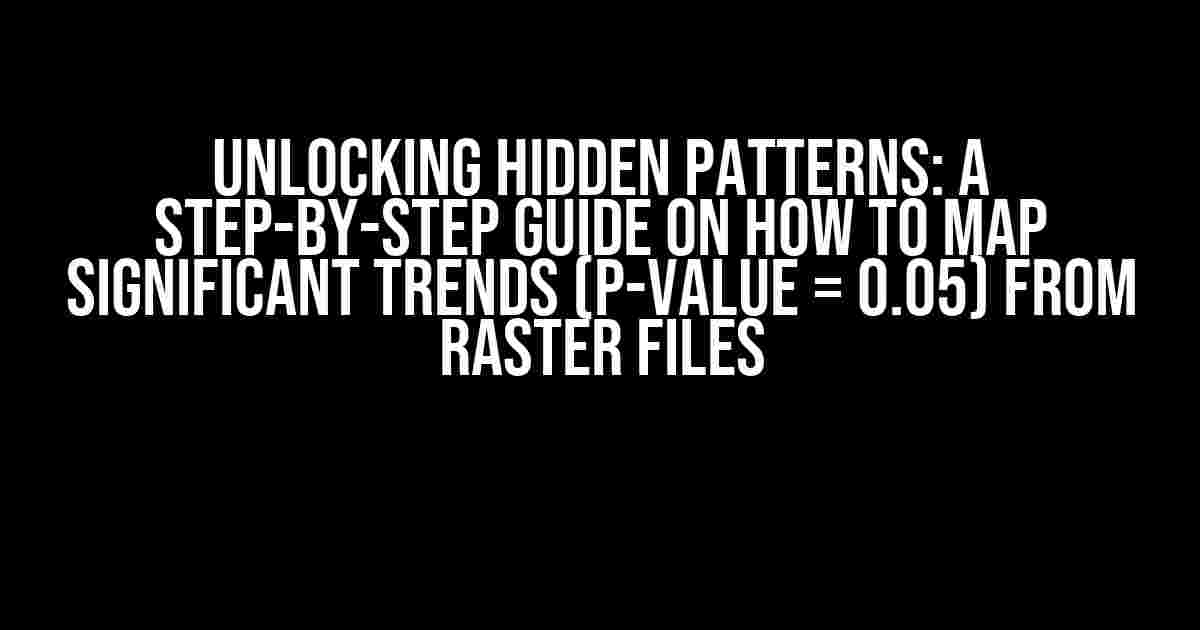Are you tired of sifting through vast amounts of data, only to find that the insights you’re looking for are hiding in plain sight? Look no further! In this comprehensive guide, we’ll demystify the process of mapping significant trends from raster files, using the magical threshold of p-value = 0.05. Buckle up, folks, and get ready to uncover the secrets of statistical significance!
What is a Raster File, and Why do We Care?
Raster files, also known as geospatial rasters or gridded data, contain spatially referenced information, such as satellite imagery, climate data, or even social media activity. These files are like digital puzzles, comprising a matrix of cells, each containing a value that represents a specific geographic location.
We care about raster files because they hold the key to understanding complex phenomena, from environmental changes to human behavior. By analyzing these files, we can identify patterns, trends, and correlations that might otherwise remain hidden. And that’s where statistical significance comes in!
The Quest for Statistical Significance (p-value = 0.05)
Statistical significance is the holy grail of data analysis. It’s the probability that an observed pattern or trend is not due to chance. In our case, we’re looking for trends with a p-value of 0.05 or less, which indicates a 95% confidence level that the observed trend is real.
So, why 0.05? This threshold is widely accepted in the scientific community as the boundary between statistically significant and insignificant results. It’s like the secret handshake of data analysis: once you’ve got a p-value of 0.05 or less, you can confidently say that your trend is more than just a coincidence!
Step 1: Prepare Your Raster File for Analysis
Before we dive into the mapping process, we need to ensure our raster file is ready for prime time. Follow these steps to prepare your file:
-
gdalinfocommand: Use this command to retrieve metadata about your raster file, such as the number of bands, data type, and spatial reference system. -
Check for no-data values: Verify that your raster file doesn’t contain no-data values, which can skew your analysis. You can use the
gdal_edit.pyscript to replace no-data values with a suitable substitute. -
Reproject your raster file (optional): If your raster file isn’t in the desired spatial reference system, use the
gdalwarpcommand to reproject it.
Step 2: Calculate the Trend
Now that your raster file is prepared, it’s time to calculate the trend. We’ll use a simple linear regression approach to identify the slope and p-value of the trend.
# Import necessary libraries
import numpy as np
from scipy.stats import linregress
# Load the raster file
raster_data = gdal.Open('your_raster_file.tif')
# Extract the data values
data_values = raster_data.ReadAsArray()
# Calculate the trend
slope, intercept, r_value, p_value, std_err = linregress(data_values)
print(f'Slope: {slope:.2f}, p-value: {p_value:.2f}')
Pay attention to the p-value output. If it’s 0.05 or less, you’ve got a statistically significant trend on your hands!
Step 3: Map the Significant Trends
With your trend calculated, it’s time to visualize the results. We’ll use a Python library called matplotlib to create a map that highlights the significant trends:
# Import necessary libraries
import matplotlib.pyplot as plt
import cartopy.crs as ccrs
import cartopy.feature as cfeature
# Create a figure and axis
fig, ax = plt.subplots(figsize=(10, 10), subplot_kw={'projection': ccrs.PlateCarree()})
# Add the raster data to the axis
ax.imshow(data_values, cmap='RdYlGn', extent=(raster_data.GetExtent()))
# Add a title and labels
ax.set_title('Significant Trends (p-value ≤ 0.05)')
ax.set_xlabel('Longitude')
ax.set_ylabel('Latitude')
# Add a colorbar
cbar = fig.colorbar(ax.images[0], ax=ax, shrink=0.5)
cbar.set_label('Trend Value')
# Show the plot
plt.show()
This code snippet will produce a beautiful map that highlights the significant trends in your raster file. The colorbar on the right indicates the trend value, with darker colors representing stronger positive trends and lighter colors representing weaker negative trends.
Step 4: Refine Your Analysis (Optional)
While our simple linear regression approach has given us a solid foundation, there are times when you might want to refine your analysis using more advanced techniques:
-
Non-parametric tests: If your data doesn’t meet the assumptions of linear regression, consider using non-parametric tests like the Mann-Kendall test or the Theil-Sen estimator.
-
Spatial autocorrelation: If your data exhibits spatial autocorrelation, use techniques like spatial lag models or conditional autoregressive models to account for this effect.
-
Bootstrap resampling: Perform bootstrap resampling to estimate the uncertainty of your trend estimates and p-values.
Conclusion
Voilà! You’ve successfully mapped significant trends from your raster file using the magical threshold of p-value = 0.05. By following these steps, you’ve unlocked the secrets of statistical significance and taken the first step toward uncovering the hidden patterns in your data.
Remember, the world of geospatial analysis is full of wonders waiting to be discovered. With the right tools and techniques, you can unravel the mysteries of your raster files and uncover insights that will leave you saying, “Ah, I see!”
| Keyword | Description |
|---|---|
| p-value | The probability that an observed pattern or trend is due to chance. |
| Raster file | A type of geospatial data file that contains spatially referenced information. |
| Statistical significance | The probability that an observed trend is real, rather than due to chance. |
| Linearity | The assumption that the relationship between variables is linear. |
| Spatial autocorrelation | The phenomenon where nearby data points are more similar than distant points. |
We hope this guide has been informative and entertaining. Happy mapping, and may the odds be ever in your favor!
Frequently Asked Question
Are you struggling to map significant trends from raster files? Worry no more! Here are the answers to the most frequently asked questions about mapping significant trends with a p-value of 0.05.
What is the importance of p-value in mapping significant trends?
The p-value is a crucial aspect in determining the significance of a trend. It represents the probability of obtaining the observed result (or a more extreme result) assuming that the null hypothesis is true. In this case, a p-value of 0.05 means that there is only a 5% chance of observing the trend by chance, making it a statistically significant trend. Mapping significant trends with a p-value of 0.05 helps you identify areas where the trend is likely not due to chance, making your analysis more reliable and accurate.
How do I prepare my raster file for trend analysis?
Before analyzing your raster file, make sure it is in a suitable format for trend analysis. Ensure that your raster file is in a continuous format, such as float or integer, and that it is projected in a suitable coordinate system. Additionally, remove any NoData values or missing data points, as they can affect the accuracy of your trend analysis.
What is the best method for calculating trends in a raster file?
There are several methods for calculating trends in a raster file, including linear regression, Mann-Kendall test, and Theil-Sen slope estimator. The choice of method depends on the nature of your data and the type of trend you are trying to identify. For example, linear regression is suitable for data with a normal distribution, while the Mann-Kendall test is more robust to non-normal data. The Theil-Sen slope estimator is a non-parametric method that is resistant to outliers.
How do I visualize and map significant trends in a raster file?
Once you have calculated the trends, you can visualize and map them using GIS software such as ArcGIS, QGIS, or Google Earth. Create a new raster file with the trend values and use a suitable color scheme to represent the direction and magnitude of the trend. You can also use clustering algorithms or hot spot analysis to identify areas with significant trends.
What are some common pitfalls to avoid when mapping significant trends in raster files?
Common pitfalls to avoid include ignoring the assumptions of the trend analysis method, not checking for spatial autocorrelation, and not considering the scale of the analysis. Additionally, be cautious of over-interpreting the results, as significant trends may not necessarily imply causality. It’s essential to consider the context of your study and the limitations of your data when interpreting the results.


